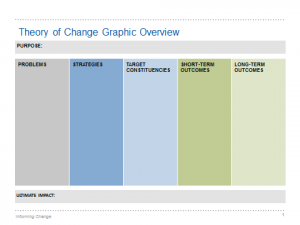The Satisfaction of Creating a Theory of Change
I’ve always enjoyed cleaning out a messy drawer or cupboard—pulling everything out, sorting the contents by category or size, choosing which items to discard and which to keep, and then putting things back in an orderly way. Sometimes the process reveals a new way to stack or arrange things, or prompts me to acknowledge that some things no longer belong in the space, like phone trees for basketball teams that my kids are no longer on and plastic ware that I’ve learned is bad to put in the microwave. There’s a satisfying, reflective aspect to handling and choosing things that are important to me. The best part of the job is the conclusion, when order, clean lines and open views replace confusion and I know that this cupboard or drawer has regained its purpose and will again be useful.
I get the same sense of satisfaction working with Informing Change’s clients to create or update a theory of change. Our clients are practitioners deep in their work, usually working with multiple strategies, scanning the environment for threats and opportunities, voraciously absorbing information, and building their understanding of what works and what doesn’t. With the volume of work or passage of time, all those strands of knowledge and experience can become tangled and confused, not unlike a well-used drawer or cupboard in my house. Similar to when I face my messy cupboards, when doing theory of change work I ask, “What’s the purpose here? Are things in place and aligned to accomplish what the client has set out to do? Are these the right strategies for the intended outcomes? Are the right target constituents given the problem to be solved?”
Answering these and similar questions is at the heart of developing a theory of change. The process brings me great satisfaction: laying out the pieces of how the client believes the change will happen, categorizing and sorting the pieces, identifying irrelevant or mismatched pieces to toss, and choosing what gets priority placement. The resulting order and clarity is an invitation to action and a good foundation for evaluation or strategic planning work.
At the conclusion of a theory of change process, the Informing Change team summarizes the client’s theory of change in a one page graphic summary. It is orderly, clean and easy to understand. And I, as with my cupboard cleaning, feel rewarded by the usefulness of the work.


